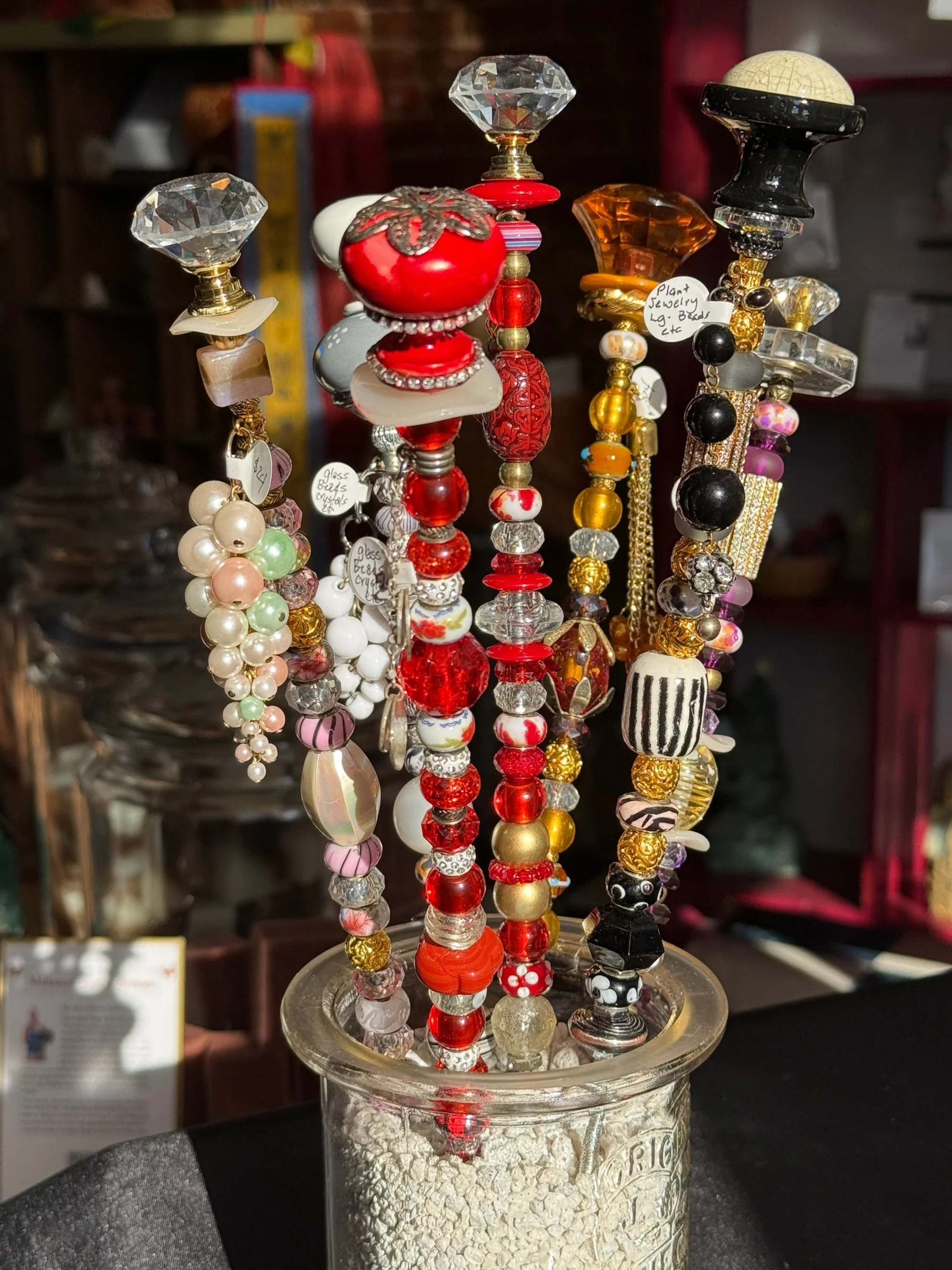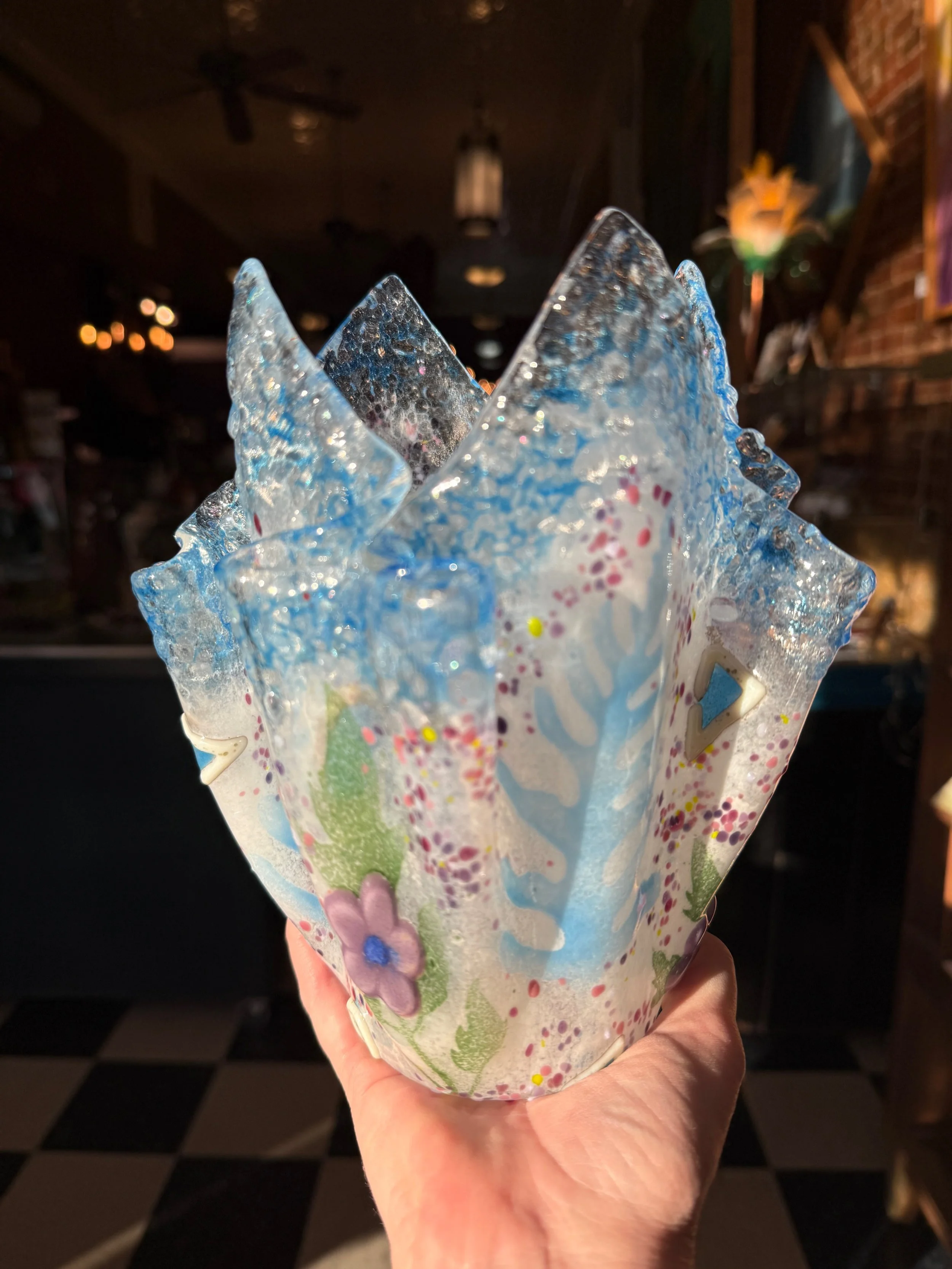Artisans
Chandler Williams-Cartozzo
Chandler Williams Cartozzo lives with her family in Nashville and runs Chandler's Dezigns, her own line of handmade jewelry. Made with only her hands and a pair of pliers, her jewelry boasts crystals and gemstones and incorporates intricate wire wrapping styles. Her deep love of Mother Earth shines in each of her pieces.
Her work can be found for sale in stores around the United States, at area craft shows and online. Chandler is a big supporter of the shop small movement and deeply believes in the importance of helping others to collectively bring positive change to the world. In her free time, she enjoys hiking, gardening and sharing with her young son the importance of caring for the natural world around us.
Samantha Malik
Samantha Malik works with multiple forms of glass, including stained glass, mosaics, and glass fusion, often including mixed media to reflect issues and trends in society. She currently lives outside of Chicago but previously lived in Kentucky and Tennessee and still has family ties here. "I like the versatility of glass; opaque, translucent, melt-it-together or cut and foil it. Mix it up and make something someone will love."
—Samantha Malik
Martha Wilcox
" I like to think that as artists, we desire to express our thoughts and feelings about life and death, joy and sad-ness, hope and despair, and many other human experiences. I think most artists realize how fortunate we are to have found a very personal way to accomplish this. There is an intimate involvement in sculpting, a connection to the piece that helps me reach, touch and hopefully connect with others." - Martha Wilcox
Jarrid Scott
Jarrid Scott is an artist, illustrator, sculptor, muralist, printmaker born and raised in Dawson Springs, Kentucky.
Jarrid creates sculptures using single use plastic as the core and most of his work is inspired by his love of nature and its power.
Jarrid received his BFA in Illustration at Savannah College of Art and Design in Atlanta and was accepted into the Governor’s School of the Arts in 2010.
Jarrid has been featured in Seventeen magazine for winning the 2011 International Stuck at Prom Duck Tape Contest and was a Kentucky Crafted artist in 2012 while receiving his undergraduate studies at Morehead State University.
His printmaking works have been published in Out of Step Books and he currently has a Mural on Ocean Drive in Miami. FL. Jarrid has also shown works throughout the South East.
Brenda Lyle
Brenda Lyle is a middle Tennessee artist who uses disassembled, found, discarded jewelry and chandeliers to create meticulously handmade, recycled, one-of-a-kind glass works.
Her plant pretties and sun catching danglers make a lovely sparkle in your space.
Dianne Carlisle
Dianne Carlisle, a Fused-Glass artist living in the Paris Landing area of TN with my husband of 40 plus years. I grew up on the Jersey Shore just a couple of blocks from the ocean. Attending Catholic Mass fueled my love for glass. I spent many hours bored but stuck in the pews, so I would make up stories about the people featured in the church's stained glass windows. At 17, my parents gifted me a trip to Spain and Morocco, and it was there that my passion ignited. Seeing all the amazing cathedrals with glass that was a thousand years old put me in awe of the power that stories in glass could tell. I knew then that at some point in my life, I would work with glass.
Many years later, I found a local college that offered stained glass classes and my journey continued. Then I found glass fusing, and the freedom it gave me was unbelievable, allowing me to create my own colors using glass powders. Working with these powders for the last 23 years, I have perfected techniques that allow me to create almost anything I can imagine. Fusing also requires a lot of science, and being self-taught in this medium, I have found that science always wins. I'm most known for my florals and seascapes which are influenced by my ocean roots and the beautiful area I live in now. My husband is my biggest fan and partner in this venture, and together, we do art fairs in the TN and KY area. My work is also in several galleries where I also teach classes.
Beverly Patterson
Beverly Patterson, a native of Gallatin, Tennessee, is an artist currently based in Nashville. Having a natural green thumb, a heart for gardening and being in nature, Beverly started curating a beautiful, bold and vibrant collection of unique art by pulling inspiration from her garden. Her collage art technique involves layering unique shapes, textures, colors and patterns onto a canvas that blossoms into a story that speaks to each viewer. Beverly's work can be seen in exhibitions through the Tennessee Art League and TN Craft. She hopes her art will bring joy to viewers, while also inspiring others to appreciate and preserve the beauty of natural environments.
Tarryl Booker
Tarryl Booker is a craftsman and an artist who loves to create. He started making waist beads as a hobby, and then it became therapeutic. Waist beads can express honor for ancestors, make a political statement, or say, "This just feels good."
Traditionally, African waist beads were worn as symbols of womanhood, fertility, protection, or spirituality as early as the 15th century. Beads are often worn as a status symbol outside the clothes.
Inside the clothes or without clothes, they are symbols to a husband or lover.
Women of all shapes and sizes can confidently adorn themselves with waist beads. They are usually worn aiono the panty or bikini line and not the actual waist, so it allows for all women to comfortably wear waist beads.
Wearing them is a personal reflection and appreciation for your God-given beauty. Wearing waist beads is deeply personal, and there is NO right or wrong reason for wearing them. They are for ALL women of ALL backgrounds & cultures.
Tina Bruce
Tina Bruce is a wife, mother and grandmother who enjoys painting, drawing, sewing and reading. She has lived in Christian County for 27 years and has been an avid supporter of Milkweed since we opened. Her quilted Microwave Cozies will hold most container types while in the microwave, allowing you to pull them out safely without burning your hands.
Laura Gillespie
Laura Gillespie creates functional pottery and whimsical clay sculptures from her studio in Cadiz, Kentucky. She’s been practicing her craft for almost 20 years, selling her work in regional shows and shops. She originally studied under Paul and Trisha Ferrell of Brushy Fork Creek.
Kevin Mize
“These lamps are a culmination of many influences. The love of nature, a background in architecture, the experience of building, and a passion for light, all combine to form these sculptures. The blooms are primarily made of re-purposed plastic containers that have been layered and heated. By making these lamps, I hope to inspire people to be less wasteful, more resourceful and to manifest beauty in whatever way possible.
Reduce, Reuse and Recycle.”
Kevin Mize, Lotek Designs
Christine Roth
“I like to make pieces that are beautiful but also functional.-that can be a part of your everyday life but also special. I also love the tactile texture. These current pieces have a very touchable glaze. My favorite pieces are the craggily ones, the rough ones. I find that there is beauty in ugly. Everyone sees something different. It’s like an ink blot test, and I like that about it. I like it heavy and tangible, where the whole family can interact with it without fear. I think that important about art. Everyone should be able to interact with it. You shouldn’t have to be so careful.”
-Christine Roth
Dodie Wrocklage-Harp
As a jewelry designer and metalsmith, my work is a testament to the delicate beauty of nature and a plea for its preservation. Inspired by the often overlooked elements in the natural world, I strive to capture ephemeral moments in wearable art. Through meticulous processes like fabrication, vitreous enameling, and lost wax casting, I aim to evoke the essence of nature’s subtle wonders. Occasionally, I incorporate actual natural objects, adding a tangible connection to the environment. My creations serve as both adornments and reminders, urging appreciation and conservation for the intricate tapestry of life that surrounds us.
“. . . I strive to capture ephemeral moments in wearable art.”













